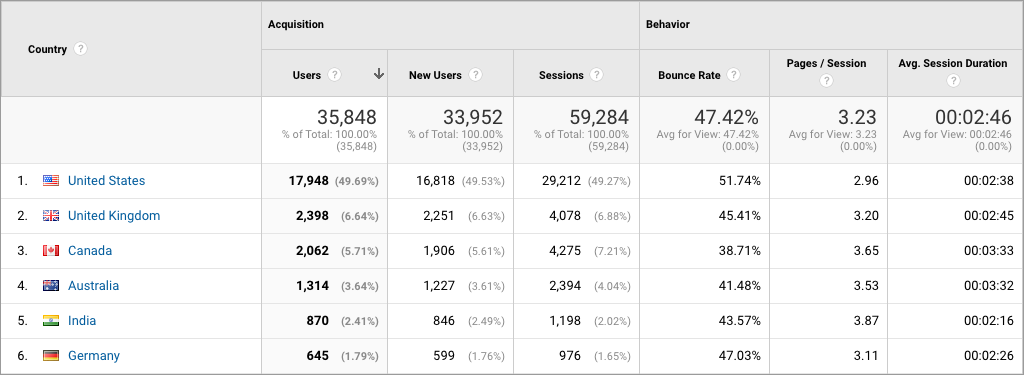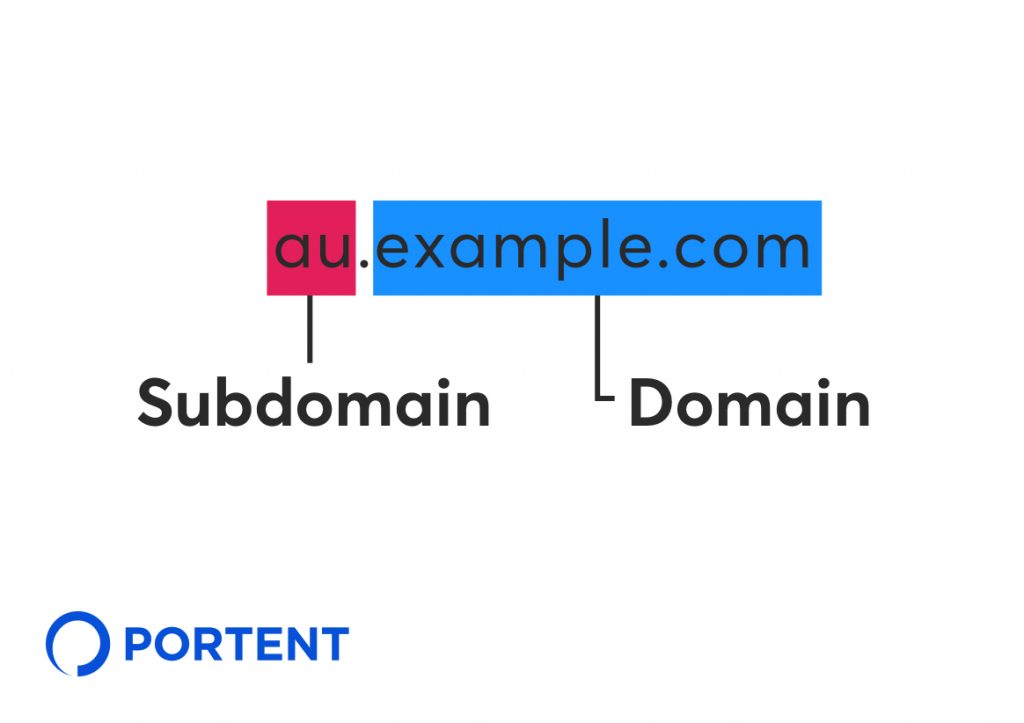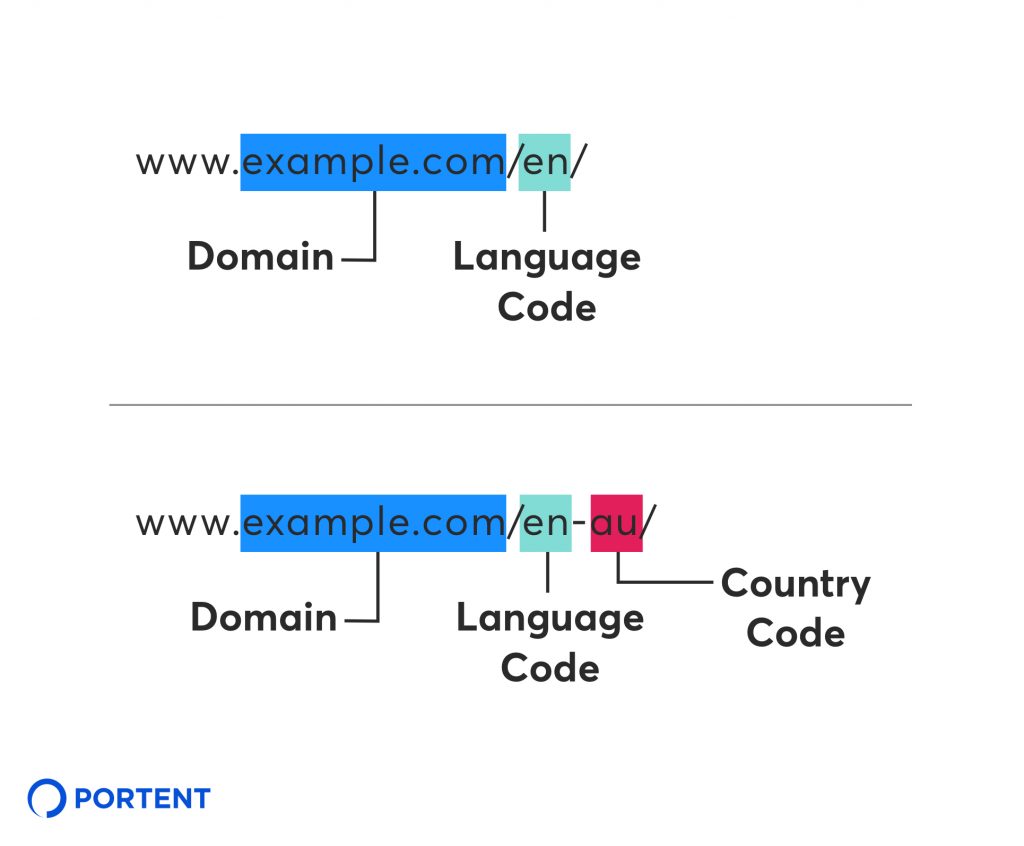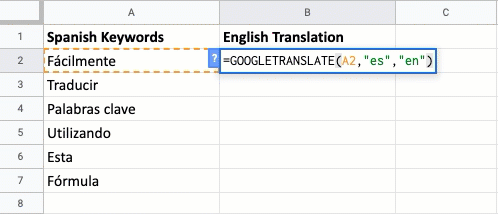88 percent of the world’s internet population is located outside of the United States. Therefore, if you’re currently only focused on targeting customers in the United States, there’s a lot more opportunity for international sales waiting for you. However, taking your business international brings some new things to think about regarding your SEO strategy, and it’s much more than just translations.
There are technical elements required for your website, and you may need to learn some new SEO best practices as Google isn’t the most dominant search engine in some countries. China, South Korea, and Russia are committed to their favorite local search engines Baidu, Naver, and Yandex, respectively.
But don’t let any of the complexities discourage you. In this post, we’ll cover the basics you need to know to get your international SEO strategy heading in the right direction:
Where to Start with Your International SEO
If you aren’t sure which countries to target first, start with your existing language. For example, if your website is in English, then consider targeting other English speaking countries (UK, Australia, Canada, etc.), as it will be easier to manage and less expensive.
Next, look at where your existing traffic is coming from. Is there a country or language that is driving a good amount of traffic to your site? If so, is the traffic converting well? It’s okay if the traffic isn’t converting yet, as you’re not optimized for that audience. But if you are converting, then that may be a great country/language to target.


Keep in mind that just because your site is in English and you plan on targeting another English speaking country doesn’t mean you shouldn’t translate your content. You still need to consider different spellings, behavior, and currencies.
Choosing a Website Architecture
Managing a website that targets multiple languages or countries can certainly be a challenge, so it’s important that when you set up your website you choose a structure that is easy for you to manage.
When it comes to setting up your website structure you have three options, and with each of them comes their unique pros and cons. Determine which one works best for you and your company, and stick with it for all of your international pages.
ccTLD (Country Code Top Level Domain)
For ccTLD there are several different domains that are used. Each of those domains is intended to target only one specific country.


Examples of ccTLD:
www.example.au – Australia
www.example.de – Germany
www.example.fr – France
Pros of ccTLD:
- Sends a strong signal to search engines as they know which country you are targeting.
- Easier to market, since users in that country are going to be used to seeing the ccTLD and that will make it easier for them to remember.
- Will not be affected by algorithm updates that impact any of your other ccTLDs.
Cons of ccTLD:
- Requires you to manage multiple websites (web hosting and maintenance costs will be higher).
- Each ccTLD will start with no authority, which will make it challenging to rank for competitive terms right away.
- Separate SEO strategies for each ccTLD (including backlinks).
Subdomains


Examples of Subdomains:
au.example.com – Australia
de.example.com – Germany
fr.example.com – France
Pros of Subdomains:
- Easy to separate different versions of your website if you prefer.
- Easy to manage as they’re all still in the same domain.
- Allows for different server locations for each subdomain.
Cons of Subdomains:
- Each subdomain will be treated as its own website and start with no authority, which will make it challenging to rank for competitive terms right away.
- Separate SEO strategies for each subdomain (including backlinks).
- Implementing hreflang tags can be difficult.
Subdirectories


Examples of Subdirectories
www.example.com/au/ for Australia
www.example.com/de/ for Germany
www.example.com/en-fr/ for English speakers in France
Pros of Subdirectories
- Good if you want to keep your gTLD (generic top-level domain: .com, .org, etc.)
- Able to use the domain’s existing SEO authority and will continue to share one backlink profile with the other language/country versions.
- Easy to implement and maintain as all of your content will be on one site.
Cons of Subdirectories
- More complex to set up and maintain with hreflang tags.
- Fewer location signals to search engines and users.
If you are going to target multiple languages and countries, I recommend using subdirectories. It’s simple to implement a country code and language format (www.example.com/fr-ca/ for French speakers in Canada).
Hreflang and HTML attributes are essential to international SEO because they tell the search engines what language and/or country the webpage is targeting. It is surprisingly common how many website owners don’t know about language tags or don’t take the time to implement hreflang tags.
Specify Both a Language and a Country
It is acceptable for hreflang and HTML lang to contain a language-only markup, a language and a region markup, but never a region-only markup. Therefore, each hreflang tag will have its own unique hreflang code.
Keep in mind that there is no language markup that specifies Spanish for Mexico and Spanish for Spain. In order to accomplish that you will have to include the country code with the language code (“es-mx” for Spanish in Mexico and “es-es” for Spanish in Spain).
Here is a full list of accepted ISO 639-1 language codes, as well as ISO 3166-1 Alpha 2 country codes.
The language code always goes before the country code. For example, the hreflang code “es-mx” for Spanish – Mexico is acceptable. However, the hreflang code “mx-es” for Mexico-Spanish will cause the hreflang tag to be ignored by search engines.
How to Add Hreflang to Your Site
There are three options for where to place hreflang tags. However, you should only use one version of hreflang on the site to avoid the potential for errors and conflicts in hreflang tags. There is not a version of hreflang that search engines preferred over the other, so choose the one that’s easiest for you to manage.
Hreflang in the page <head>
Within the head code of each webpage, you can add the hreflang tags. Here is an example of what the hreflang tag looks like on every page:
<head>
<title>Portent - Digital Marketing Agency</title>
<link> rel="alternate" hreflang="en-us"
href = "https://www.example.com/"/>
<link> rel="alternate" hreflang="en-gb"
href = "https://www.example.com/en-gb/"/>
<link> rel="alternate" hreflang="de"
href = "https://www.example.com/de/"/>
<link> rel="alternate" hreflang="ca-fr"
href = "https://www.example.com/ca-fr"/>
<link> rel="alternate" hreflang="x-default"
href = "https://www.example.com/"/>
</head>
Hreflang in the XML Sitemap
Another option for adding hreflang to a website is through the XML sitemap. This can be a good option if you want to keep the code of your webpages clean. The XML Sitemap method works just as well as adding the hreflang directly to the webpages.
<url>
<loc>https://www.example.com/</loc>
<xhtml:link
rel="alternate"
hreflang="en-au"
href="https://www.example.com/en-au/"/>
<xhtml:link
rel="alternate"
hreflang="en-gb"
href="https://www.example.com/en-gb/"/>
<xhtml:link
rel="alternate"
hreflang="de"
href="https://www.example.com/de/"/>
</url>
Hreflang in the HTTP Header
The final method for implementing hreflang tags is for non-HTML content such as PDFs that you would like to optimize for multiple languages. These hreflang tags will go into the HTTP headers of the non-HTML content.
The HTTP header hreflang tags should look like this:
Link: <http://www.example.com/file-a.pdf>; rel="alternate"; hreflang="en",
<http://www.example.com/fr-ca/file-a.pdf>; rel="alternate"; hreflang="fr-ca",
<http://www.example.com/de/fila-a.pdf>; rel="alternate"; hreflang="de"
Hreflang Best Practices
- Each webpage must refer to itself in the hreflang as well as all of the other language versions.
- Do not use relative URLs, only absolute URLs. For example, use https://www.example.com/abc, not example.com/abc or /abc.
- Every language version of a webpage should have a rel=”canonical” link point to itself.
- The pages you are linking to in the hreflang must also link back through hreflang on those pages as well. So, if the French page contains an hreflang tag linking back to the German page, the German page must contain an hreflang tag pointing back to the French page. If you don’t have the hreflang tags reciprocate, search engines will ignore the hreflang tag of that page entirely.
- Audit your hreflang tags regularly to make sure they are still set up correctly.
- Consider using an x-default for languages not specific in the page’s hreflang.
X-Default Hreflang Attribute
The x-default attribute is included in the hreflang attribute and is primarily used to provide a default page when the user’s browser language does not match any of the hreflang attributes. The x-default hreflang is most commonly used on a homepage that employs a country/language selector.
However, it is also an option to define a specific language/location version of the site as the x-default option as a fallback if no other pages are suitable. English is a reasonably good language to include as the fallback option, as it is commonly spoken globally. Keep in mind that the x-default hreflang link attribute is currently only supported by Google and Yandex.
Here is an example of what the x-default element looks like in the HTML version of the hreflang attribute:
<link rel="alternate" href="https://www.example.com/" hreflang="x-default" />
HTML Lang Attribute
A lot of websites don’t include HTML lang onto their international pages. Perhaps it’s because Google ignores HTML lang attributes? Regardless of how Google uses the tags, it’s still essential to have HTML lang on your pages, as Bing, Baidu, and Naver depend on HTML lang to determine the language of the page.
The HTML lang attribute is used similarly to the hreflang tag by helping search engines identify the language of the page. Including HTML lang will help search engines that depend on it to provide it in relevant search results for the target country and language.
If your page is in HTML, use the following HTML lang attribute embedded into the <head> Section of your page:
<meta http-equiv="content-language" content="en-us">
Another option is to embed the HTML lang in either the <html> or the <title> element using one of the following formats:
<html lang="en-us">
<title lang="en-us">
The priority order for the HTML lang attributes is: <meta>, <html>, <title>. So if your page uses the <meta> tag it will override all other tags on the page. Use only one option per page to avoid any errors.
You can use either a language code (“es”) or a language and a country code (“es-mx”), but never just a country code (“mx”).
The HTML lang uses ISO 639 language codes and ISO 3166 country codes.
Google Search Console International Targeting Report
Once you have your website structure set up you should inform Google which version of your website is targeting which country. You can do this by logging into your Google Search Console (free tool), select your region-specific URL, click on the Legacy Tools and Reports option in the side navigation, and select International Targeting. The international targeting section will show you your hreflang errors on your site and allow you to select your target country.
Learn more about how to set up your Google Search Console.
How to Redirect Visitors to the Right Version of the Site
Automatic redirects based on the user’s IP address are problematic and can often result in poor user experience. It may seem straightforward which language a majority of users will speak in a particular country, but some countries have two to three main languages, or users may be tourists and not speak the native language. Not only that, but automatic redirects may also cause crawl issues, as search engines often crawl from the United States.
So how do you determine what language to take users to? The first option is to select the default language that is displayed based on the user’s browser settings. The second option, which gives a better user experience, is to simply ask the user for their language preferences, which can be done using an x-default hreflang attribute.
Web Hosting and CDNs
It used to be that hosting your website in the same country that you’re targeting sent a stronger signal to search engines, but that is no longer the case.
However, not having your website hosted in the same region as your target audiences will cause your site to load slowly for those users. A slow website will turn away many visitors, as most of them expect a page to load in less than three seconds. Not only that, but most search engines also prefer fast-loading websites as well.
You can provide a faster load time for your regional users by leveraging a content delivery network (CDN). CDNs allow you to cache sections of your website in a different location temporarily, so it’s delivered faster for regionally specific users. Therefore, the CDN will reduce the time a content request has to travel as it can pull it from the nearby CDN as opposed to going all the way to the original server and back.
CDNs are only one way to improve the speed and quality of content that is delivered to your users. Other best practices should still be considered to improve your page speed performance.
Managing Multi-Regional Web Content
By now you should have the technical elements set up for your website to succeed internationally, but don’t stop there. You want to make sure you get the most out of your efforts and the most out of the international version of your website, so it’s important to know how to manage and create content for your international audiences.
Over 56% of consumers say that translations in their native language are more important than price, according to a survey done by Common Sense Advisory. So competing in foreign markets with a non-translated website is no longer a viable option if you want to be successful.
When working with a translator, it’s important to communicate how you want your content translated, as there are three different ways:
Universal Translation
A universal translation is ideal for targeting multiple countries that speak the same language. For example, you can use universal translation to target major Spanish speaking markets (Spain, Mexico, Colombia, Brazil, and Argentina) but it will not target a specific dialect or expressions used by a specific group of Spanish speakers.
Regionalized Translation
Regionalized translations target specific regions. For example, there are two different forms of Chinese, Simplified Chinese and Traditional Chinese (also known as Standard Chinese and Mandarin). Simplified Chinese is spoken in Mainland China, Malaysia, and Singapore. However, the Simplified Chinese spoken in Singapore is still different than that of Mainland China’s. Meanwhile, Traditional Chinese is spoken in Taiwan and Hong Kong. However, the phrasing and vocabulary can be very different between Taiwan and Hong Kong as well.
Localized Translation
A localized translation is essential when you are trying to target an audience of a specific country. Localizations will include dialects, cultural aspects, and idiosyncrasies of a particular audience. I recommend learning more about the importance of localizing content for your international audience if you’re not familiar with it already.
If you want localized or regionalized translations, it is highly recommended that you hire an expert that lives in the country you are targeting and speaks the native language. The translator will also be able to provide insights into the official dialect, slang terms, cultural references, and tone you would miss if you used just a translator, or worse, a machine translator.
If you need to localize or regionalize content that already exists, do not translate the content precisely from one language to the other. To get the best result follow these three steps:
- Summarize the original text into bullet points.
- Have a professional translate the bullet points into the target language.
- Use the translated bullet points to create the newly translated content for the target language.
Keyword Research for International SEO
When you conduct keyword research for a new language, the same rules apply, as mentioned earlier, have the keywords properly translated by a professional. Don’t copy and paste your existing keywords into a machine translator to find a translated version of the keywords. When you do this, you run the risk of mistranslated words, missing out on nuances and subtleties, or providing low-quality content which could result in not ranking well in the search results.
Once your translator has provided you with a list of potential keywords, you need to do your own research to identify the keywords with the highest search volume and finding other valuable opportunities with the list provided. I recommend using either SEMrush, Ahrefs, or Dragon Metrics to find the search volume of international keywords.
After you have a defined list of keywords for your target language and/or country the ongoing process is the same as what you’ve been doing—expand your keyword list based on the search terms in your Google Search Console data and keyword research tools, test new keywords, and revise your list to include the top-performing keywords.
Understandably, most of the keywords you research won’t make sense to you. This is the one instance you can use Google Translate to see if the keyword is truly relevant and worth pursuing. There’s also a nice feature in Google Sheets that allows you to translate cells using the GOOGLETRANSLATE formula.


Before you finalize your list of keywords, perform some competitive analysis. If you know of any competitors in the countries you are targeting, look at what keywords they’re targeting. You can do this by adding the competitor’s domain (or a specific URL if you only compete in some areas), pasting it into your preferred keyword research tool, and looking at their top organic performing keywords. Use Google Translate to determine if they are relevant to what you offer and add them to your keyword list if they are.
International On-Page SEO
One of the most common international SEO mistakes that I see is that not all of the on-page SEO elements are translated.
Do not keep any of the on-page elements in English when targeting another language. If you have two (or more) languages on one page you will not only send poor signals to search engines but also to your users, likely losing their trust.
Not only that but if you set up all of the technical elements and don’t optimize everything on the pages, you’re going to be wasting a lot of time and energy.
As a best practice, Include your translated keywords a few times naturally into the following elements:
- Page copy
- URL
- Header and subheadings
- Page title
- Meta description
- Images – file name and words in the images
- Image alt tag
- Anchor text for internal linking
- Navigation titles
- Include a local phone number and address in the footer if available
Again, have someone that speaks the language optimize these elements so you’re not guessing where keywords should go.
Non-English Characters in URLs
English characters are not required for URLs. You can use Hebrew, Arabic, Japanese, Chinese, and characters from all other languages (excluding special characters). Google Senior Webmaster Trends Analyst John Mueller said, “Yes, non-English words and URLs are fine, [and] we recommend using them for non-English websites.” However, if the language has letter accents you should remove the accents.
Here is a tool to remove the letter accents to keep your URLs clean.
How to Search From Any Location
Search engines like to provide personalized results to their users. Therefore, if you are trying to view the SERP of another country it may not work or it will likely not be very accurate.
There are various technical workarounds to view the SERPs of another country, but I like to keep things simple, which is why I use Bright Local’s Search Results Checker. It’s a free tool and works very well while in incognito.
Bright Local’s tool also allows you to search at a hyper-local such as a specific city or area code. This will be very beneficial if you are also conducting local SEO efforts in other countries.
There are many other tools out there, but these are the essentials you should be using, and my favorites from over the years. I encourage you to also try other tools and ask what others are using.
Remember: Start Local and Grow Global
If you have identified a lot of marketing opportunities and you’re ready to take your business international, this post will serve as a great starting point to optimize your international SEO.
However, it’s expensive and requires many resources to take a website global; therefore it is important that you don’t overextend yourself or your abilities. Focus your efforts in one area at a time, so you don’t stretch yourself or your budget too thin. Narrow your target market by demographics or search engines. Start out small then expand over time, and be strategic.
The post How to Target International Users with SEO appeared first on Portent.








